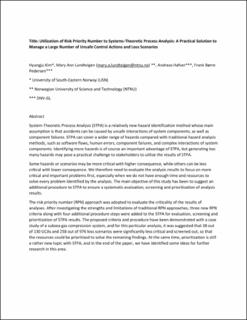| dc.description.abstract | System-theoretic process analysis is a hazard identification method whose main assumption is that accidents can be caused by unsafe interactions of system components, as well as component failures. System-theoretic process analysis can cover a wider range of hazards compared with traditional hazard analysis methods, such as software flaws, human errors, component failures, and complex interactions of system components. Identifying more hazards is of course an important advantage of system-theoretic process analysis, but generating too many hazards may pose a practical challenge to stakeholders to utilize the results of system-theoretic process analysis. Some hazards or scenarios may be more critical with higher consequence, while others can be less critical with lower consequence. We therefore need to evaluate the analysis results to focus on more critical and important problems first, when we do not have enough time and resources. The main objective of this study has been to suggest an additional procedure to system-theoretic process analysis to ensure a systematic evaluation, screening, and prioritization of analysis results. The risk priority number approach was adopted to evaluate the criticality of the results of analyses. After investigating the strengths and limitations of traditional risk priority number approaches, three new risk priority number criteria along with four additional procedure steps were added to the system-theoretic process analysis for evaluation, screening, and prioritization of system-theoretic process analysis results. The proposed criteria and procedure have been demonstrated with a case study of a subsea gas compression system, and for this particular analysis, it was suggested that 38 of 130 unsafe control actions and 258 of 976 loss scenarios were significantly less critical and screened out, so that the resources could be prioritized to solve the remaining findings. Meanwhile, prioritization is still a rather new topic with system-theoretic process analysis, and in the end of the article, we have identified some ideas for further research in this area | en_US |
